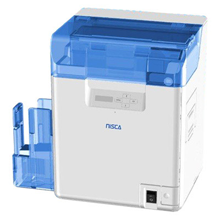A proximity card printer – more commonly known as a reverse retransfer printer – was de

signed specifically to print on ID cards with uneven surfaces. Proximity cards have a small chip and antenna that run throughout the card, so printing on a standard direct-to-card printing can potentially damage these important internal elements. In addition, it can also cause damage a direct-to-card printer's printhead, resulting in a costly printhead replacement or repairs.
By using a reverse transfer printing on proximity cards, you will eliminate the risk of damaging the card or the printhead during the printing process. There are also other valuable benefits for using reverse transfer printers, including:
- Over-the-edge printing – The printhead prints images and text directly onto a transparent film. The printed surface of the film is film is fused onto the surface of the card using very high heat, allowing a "full bleed" that covers the entire surface of the card. This virtually eliminates even the slightest white border and provides crisp, high-definition images.
- Longer card usage – The transparent film used in retransfer printing actually makes a card more durable by adding an extra layer of protection to the card.
- No printhead repair or replacement costs – Nearly all reverse transfer printers offer a lifetime printhead warranty. Additionally, the exclusive printing process of these types of printers help reduce waste of card stock during the printing process.
 In addition to using this type of printer for proximity card printing, reverse transfer printers can also be used to print smart cards, key tags, pre-punched cards, and more.
In addition to using this type of printer for proximity card printing, reverse transfer printers can also be used to print smart cards, key tags, pre-punched cards, and more.
| For more information on reverse transfer printers and whether they're the right solution for your ID card printing program, contact a knowledgeable ID Professional today at (800) 321-440t or chat now. We're here to help! |
 signed specifically to print on ID cards with uneven surfaces. Proximity cards have a small chip and antenna that run throughout the card, so printing on a standard direct-to-card printing can potentially damage these important internal elements. In addition, it can also cause damage a direct-to-card printer's printhead, resulting in a costly printhead replacement or repairs.
By using a reverse transfer printing on proximity cards, you will eliminate the risk of damaging the card or the printhead during the printing process. There are also other valuable benefits for using reverse transfer printers, including:
signed specifically to print on ID cards with uneven surfaces. Proximity cards have a small chip and antenna that run throughout the card, so printing on a standard direct-to-card printing can potentially damage these important internal elements. In addition, it can also cause damage a direct-to-card printer's printhead, resulting in a costly printhead replacement or repairs.
By using a reverse transfer printing on proximity cards, you will eliminate the risk of damaging the card or the printhead during the printing process. There are also other valuable benefits for using reverse transfer printers, including:
 In addition to using this type of printer for proximity card printing, reverse transfer printers can also be used to print smart cards, key tags, pre-punched cards, and more.
In addition to using this type of printer for proximity card printing, reverse transfer printers can also be used to print smart cards, key tags, pre-punched cards, and more.
